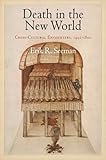Death in the New World : Cross-Cultural Encounters, 1492-18 / Erik R. Seeman.
Material type: TextSeries: Early American StudiesPublisher: Philadelphia : University of Pennsylvania Press, [2011]Copyright date: ©2010Description: 1 online resource (384 p.) : 28 b/wContent type:
TextSeries: Early American StudiesPublisher: Philadelphia : University of Pennsylvania Press, [2011]Copyright date: ©2010Description: 1 online resource (384 p.) : 28 b/wContent type: - 9780812242294
- 9780812206005
- Cross-cultural studies -- America
- Cross-cultural studies -- America
- Death -- America -- History
- Death -- America -- History
- Funeral rites and ceremonies -- America -- History
- Funeral rites and ceremonies -- America -- History
- Mourning customs -- America -- History
- Mourning customs -- America -- History
- American Studies
- HISTORY / North America
- American History
- American Studies
- online - DeGruyter
- Issued also in print.
| Item type | Current library | Call number | URL | Status | Notes | Barcode | |
|---|---|---|---|---|---|---|---|
 eBook
eBook
|
Biblioteca "Angelicum" Pont. Univ. S.Tommaso d'Aquino Nuvola online | online - DeGruyter (Browse shelf(Opens below)) | Online access | Not for loan (Accesso limitato) | Accesso per gli utenti autorizzati / Access for authorized users | (dgr)9780812206005 |
Browsing Biblioteca "Angelicum" Pont. Univ. S.Tommaso d'Aquino shelves, Shelving location: Nuvola online Close shelf browser (Hides shelf browser)

|

|

|

|

|

|

|
||
| online - DeGruyter El Salvador in the Aftermath of Peace : Crime, Uncertainty, and the Transition to Democracy / | online - DeGruyter Reading Women : Literacy, Authorship, and Culture in the Atlantic World, 15-18 / | online - DeGruyter Electing the President, 2008 : The Insiders' View / | online - DeGruyter Death in the New World : Cross-Cultural Encounters, 1492-18 / | online - DeGruyter The Essential Dürer / | online - DeGruyter Human Rights and Labor Solidarity : Trade Unions in the Global Economy / | online - DeGruyter English Letters and Indian Literacies : Reading, Writing, and New England Missionary Schools, 175-183 / |
Frontmatter -- Contents -- Illustrations -- Introduction: Ways of Dying, Ways of Living -- Chapter 1. Old Worlds of Death -- Chapter 2. First Encounters -- Chapter 3. Burial and Disinterment in the Chesapeake -- Chapter 4. Holy Bones and Beautiful Deaths in New France -- Chapter 5. Grave Missions: Christianizing Death in New England -- Chapter 6. Across the Waters: African American Deathways -- Chapter 7. Crossing Boundaries, Keeping Faith: Jewish Deathways -- Chapter 8. Burial and Condolence in the Seven Years' War -- Conclusion: Ways of Living, Ways of Dying -- Notes -- Index -- Acknowledgments
restricted access online access with authorization star
http://purl.org/coar/access_right/c_16ec
Reminders of death were everywhere in the New World, from the epidemics that devastated Indian populations and the mortality of slaves working the Caribbean sugar cane fields to the unfamiliar diseases that afflicted Europeans in the Chesapeake and West Indies. According to historian Erik R. Seeman, when Indians, Africans, and Europeans encountered one another, they could not ignore the similarities in their approaches to death. All of these groups believed in an afterlife to which the soul or spirit traveled after death. As a result all felt that corpses-the earthly vessels for the soul or spirit-should be treated with respect, and all mourned the dead with commemorative rituals. Seeman argues that deathways facilitated communication among peoples otherwise divided by language and custom. They observed, asked questions about, and sometimes even participated in their counterparts' rituals.At the same time, insofar as New World interactions were largely exploitative, the communication facilitated by parallel deathways was often used to influence or gain advantage over one's rivals. In Virginia, for example, John Smith used his knowledge of Powhatan deathways to impress the local Indians with his abilities as a healer as part of his campaign to demonstrate the superiority of English culture. Likewise, in the 1610-1614 war between Indians and English, the Powhatans mutilated English corpses because they knew this act would horrify their enemies.Told in a series of engrossing narratives, Death in the New World is a landmark study that offers a fresh perspective on the dynamics of cross-cultural encounters and their larger ramifications in the Atlantic world.
Issued also in print.
Mode of access: Internet via World Wide Web.
In English.
Description based on online resource; title from PDF title page (publisher's Web site, viewed 24. Apr 2022)


